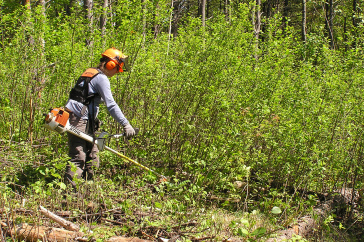The University of New Hampshire is a flagship research university that inspires innovation and transforms lives in our state, nation and world. More than 16,000 students from all 50 states and 71 countries engage with an award-winning faculty in top ranked programs in business, engineering, law, health and human services, liberal arts and the sciences across more than 200 programs of study. UNH’s research portfolio includes partnerships with NASA, NOAA, NSF and NIH, receiving more than $100 million in competitive external funding every year to further explore and define the frontiers of land, sea and space.
UNH Research Finds Eastern White Pine Thrives When Glossy Buckthorn Removed

Researchers experimented with manually cutting buckthorn to control it. They have found that cutting plants at the base sets them back and liberates the native plants with which they compete. Credit: UNH
DURHAM, N.H. – Researchers at the University of New Hampshire have found that the economically valuable eastern white pine thrives when the invasive glossy buckthorn shrub is actively managed in New Hampshire forests.
“The forest products industry is important to New Hampshire’s economy and eastern white pine is one of our most valuable tree species,” said Tom Lee, associate professor of forest ecology. “Anything, including invasive shrubs, which inhibits eastern white pine growth is of concern to the industry and should thus be a concern to the people of the state.”
According to the North East State Foresters Association, the annual value of sales of New Hampshire’s forest products industry totals nearly $1.4 billion.
The research was conducted by Lee; Steve Eisenhaure, land use coordinator with the UNH Office of Woodlands and Natural Areas; and Ian Gaudreau, former UNH graduate student in environmental engineering. The research “Pre-logging Treatment of Invasive Glossy Buckthorn (Frangula alnus Mill.) Promotes Regeneration of Eastern White Pine (Pinus strobus L.)” is presented in the journal Forests.
Researchers removed buckthorn stems by manual cutting with brush saws or with flame guns. After five treatments over two years, the stands were clear-cut or thinned in the winter of 2009-2010. Three and five years after logging, researchers found reduced glossy buckthorn in treated areas, and greater heights and densities of eastern white pine seedlings. However, the invasive shrub was not eradicated at any site, and where new glossy buckthorn thickets formed, eastern white pine seedling growth was reduced.
Cutting and flaming had similar effects, but both treatments were very expensive to apply. Going forward, the researchers will examine less expensive approaches to limiting the effects of glossy buckthorn, such as herbicides. Researchers currently are investigating other methods to control glossy buckthorn using an orchard of the fast-growing shrub at UNH’s Kingman Research Farm.
This material is based upon work supported by the NH Agricultural Experiment Station, through joint funding of the National Institute of Food and Agriculture, U.S. Department of Agriculture, under award number 0225004, and the state of New Hampshire.
Founded in 1887, the NH Agricultural Experiment Station at the UNH College of Life Sciences and Agriculture is UNH’s original research center and an elemental component of New Hampshire's land-grant university heritage and mission.
-
Media Contact
Lori Tyler Gula, PhD | NH Agricultural Experiment Station | lori.gula@unh.edu | 603-862-1452
Latest News
-
November 6, 2025
-
November 5, 2025
-
October 24, 2025
-
October 8, 2025
-
October 2, 2025













































